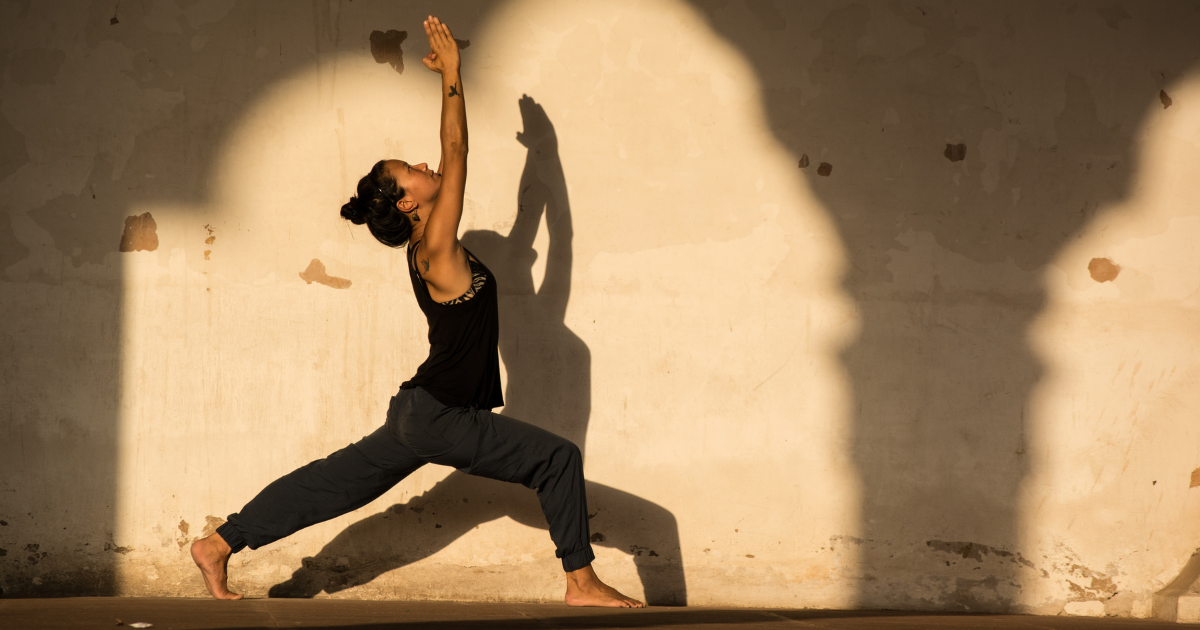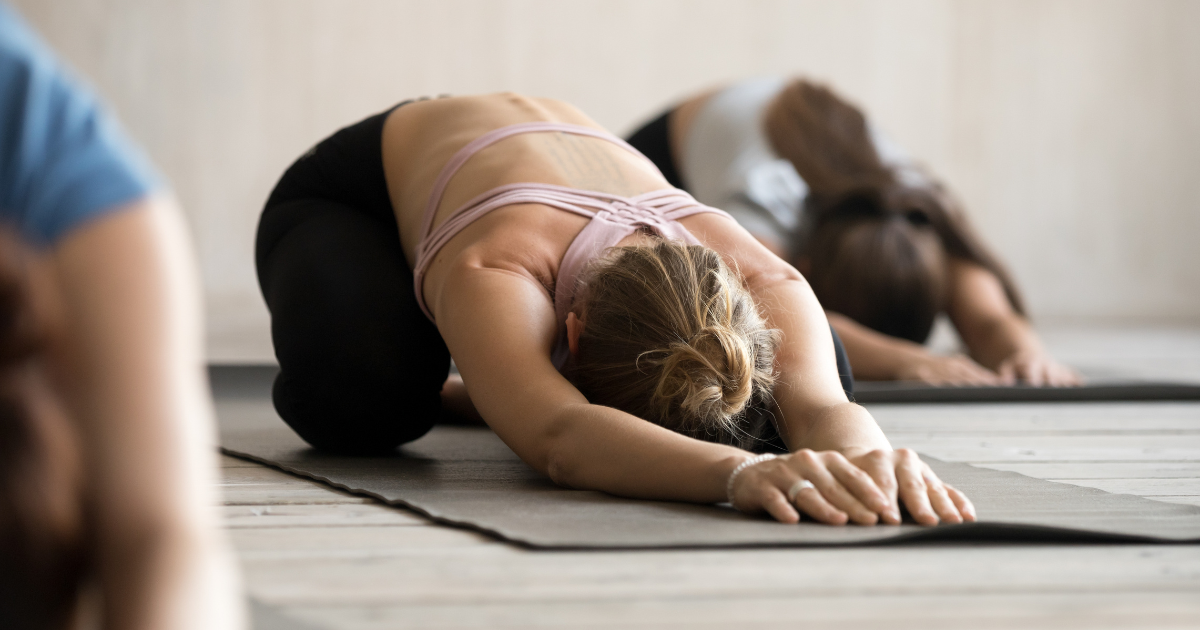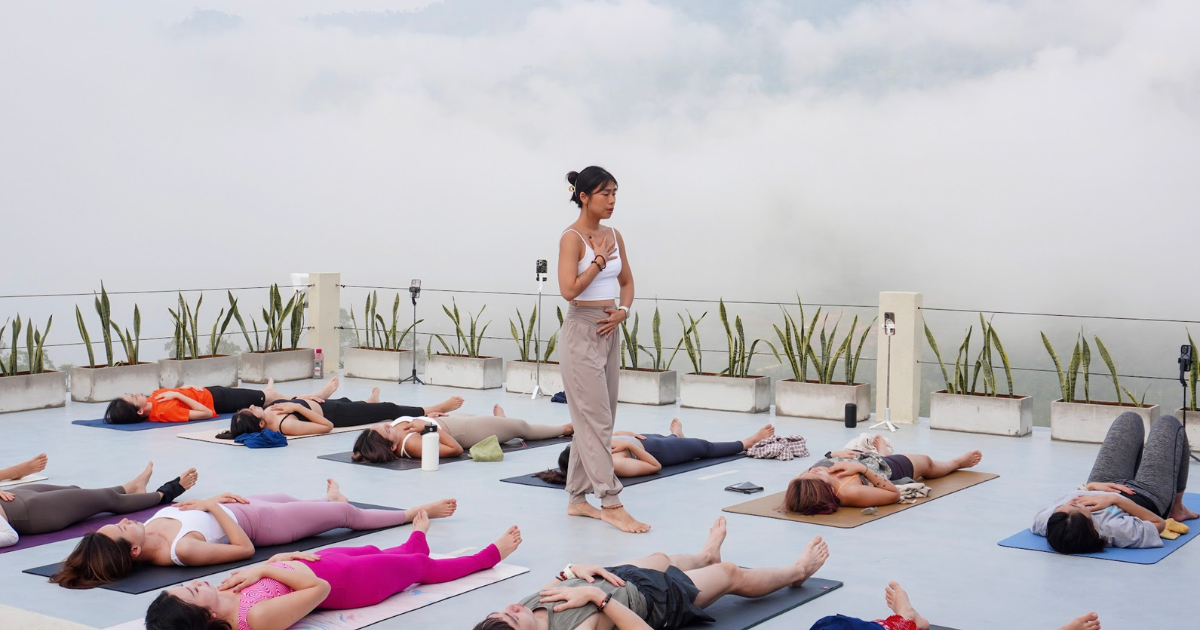What's your first impression of yoga? If you're like most people, you might think yoga is all about stretching. While it's not entirely wrong, yoga is much more than that.
Stretching is a fundamental aspect of physical health. It's vital for easing tension, maintaining flexibility, and preventing injury. Yoga enhances this by incorporating stretches that improve blood flow throughout the body and build strength in different areas of the body.
In this article, we will share 10 yoga poses that give you a good stretch, help you release muscle tension, and boost your flexibility.
1. Downward Facing Dog

Downward Facing Dog is a foundational yoga pose that serves as a full-body stretch, emphasizing the hamstrings and calves.
How to do it: Start on your hands and knees, ensuring your hands are slightly in front of your shoulders and your knees are below your hips. Spread your fingers wide and press firmly on the yoga mat through your palms. Lift your hips toward the ceiling as you straighten your legs, keeping your knees slightly bent if you have tight hamstrings. Aim to press your heels down, stretching toward the floor, while lengthening your spine.
This pose strengthens core strength and improves flexibility in the hamstrings and calf muscles. As you press your shoulders towards your knees, maintaining a bend in the knees if necessary, you engage the upper body muscles.
Remember to inhale deeply as you lift your hips, optimizing the stretch and benefiting from increased blood flow and tension release in the hamstrings and calves.
2. Child's Pose

Child's Pose is a restorative yoga posture emphasizing relaxation and stretching of the thighs and calves.
How to do it: Begin by kneeling on the floor with a rolled blanket or towel between your thighs and calves for additional support, if needed. Sit back on your heels, then slowly fold forward, extending your arms in front of you. Allow your forehead to touch the floor, creating a gentle stretch throughout your back, and breathe deeply to enhance the stretch and relaxation.
This pose is excellent for improving hip mobility and providing a gentle stretch to the back and shoulders. A blanket or towel can make the pose more comfortable, allowing beginners to fully experience its restorative effects. Breathing deeply in this position helps to release tension and promote relaxation and calm.
3. Warrior I

Warrior I is a powerful pose that strengthens and stretches the legs and back.
How to do it: Begin by standing with your feet roughly parallel, then step one foot back about three to four feet, turning the back foot slightly outward. Bend your front knee to a 90-degree angle, ensuring it stays above the ankle. Raise your arms above your head, keeping your gaze forward and your spine straight. This pose challenges your balance and flexibility while stretching the thighs and the back.
The alignment of your feet and the bending of the front knee in Warrior I help to create a strong foundation that improves focus and balance. The stretching action not only benefits the legs but also opens the chest and shoulders, encouraging deep, steady breathing. Holding this pose builds strength in the legs and back, making it a beneficial stretch for beginners.
4. Warrior II

Warrior II is an extension of the strength and flexibility developed in Warrior I.
How to do it: From Warrior I, open your hips, chest, and shoulders sideways, extend your arms parallel to the floor at shoulder height, palms facing down. Bend your right knee so it's directly over your ankle, keeping the knee in line with the second toe. Your back foot should be at a 45-degree angle, with both legs active and strong. Look over your right hand, keeping your torso open and aligned over your hips. This pose stretches the glutes and hamstrings while building strength.
Warrior II enhances stability and concentration, with the extended arms and focused gaze helping to develop core strength and balance.
The position of the legs, with one knee bent and the other leg straight, engages the glutes and hamstrings, providing a deep stretch and strengthening effect. This pose is also a part of the warrior poses series, known for its empowering and strengthening qualities.
5. Standing Forward Bend

Standing Forward Bend deeply stretches the hamstrings and calves while offering a moment of relaxation for the mind.
How to do it: Stand straight, then gently bend at the hips (not the waist) to lower your upper body towards the legs. Keep your knees slightly bent to avoid strain. You can hold opposite elbows to deepen the stretch. With each exhale, allow your upper body to come closer to your legs, promoting spinal flexion and relaxation of the neck and shoulders.
This pose is often included in the sun salutation sequence and is excellent for relieving tension in the back and legs. The hip flexors are gently stretched, improving flexibility and aiding in mobility. Remember to gently bend and straighten the knees to find a comfortable stretch, allowing gravity to pull your upper body closer to your legs.
6. Triangle Pose

Triangle Pose is a standing pose that stretches your hips, thighs, and chest, improving overall balance and stability.
How to do it: Begin with your feet wide apart, turning one foot out to a 90-degree. Extend your arms to the sides, then stretch your torso to the side over your front leg, keeping your legs straight. Place your hand on your shin, a yoga block, or the floor, and extend your other arm toward the ceiling. Rotate your chest toward the ceiling, keeping your chest open and shoulders stacked.
This pose stretches your hips and chest, strengthens your legs, and improves mobility in everyday life. A yoga block can help maintain balance and alignment, making the pose accessible to beginners. It encourages the chest and shoulders to open, enhancing breathing and posture.
7. Bridge Pose

Bridge Pose is a gentle inversion known for its ability to relieve stress and improve spinal flexibility.
How to do it: Lie on your back with your knees bent and feet flat on the floor, hip-width apart. Press your feet and arms into the floor as you lift your hips toward the ceiling, clasping your hands under your back. Keep your thighs and feet parallel as you hold the pose, breathing deeply. This pose strengthens the back, buttocks, and hamstrings while stretching the chest, neck, and spine.
Practicing Bridge Pose can be particularly beneficial for those looking to experience the benefits of yoga, including improved circulation and relaxation.
It's an accessible yoga pose for beginners, offering a gentle way to explore backbends and inversions, which are known to boost energy levels and alleviate mild depression by reversing the blood flow and rejuvenating the mind.
8. Seated Forward Bend

Seated Forward Bend is a calming pose that stretches the spine, shoulders, and hamstrings.
How to do it: Begin seated with your legs straight before you and your spine erect. If needed, place a folded blanket under your hips for added height. Inhale and lengthen your spine upward, exhale, and bend forward from the hips, reaching for your feet. Keep your spine long and avoid rounding the back, aiming to bring your upper body closer to your legs with each breath.
This pose is ideal for beginning yoga practitioners as it helps to calm the mind and stretch the body deeply. Folding forward can also aid digestion and stimulate the internal organs. A folded blanket under the hips can make the pose more accessible, allowing beginners to experience the full benefits of the stretch while maintaining alignment and comfort.
9. Cobra Pose

Cobra Pose, or Bhujangasana, is a gentle backbend that strengthens the spine and helps to open the chest and shoulders.
How to do it: Start by lying flat on the floor with your palms facing down under your shoulders. Tuck your tailbone, pressing your pubic bone into the yoga mat. As you inhale, slowly lift your chest off the mat, keeping your elbows close to your body. Hold this pose for 5 to 10 breaths before gently releasing back to the floor.
This pose not only stretches the muscles in your shoulders, chest, and abdominals but also helps release tension in the lower back, making it a perfect introduction to balancing postures in your daily practice.
While performing Cobra Pose, it's essential to ensure that you engage your back muscles and not just rely on arm strength. This engagement helps build strength and flexibility, preparing you for more challenging arm balances and standing poses. Remember to breathe deeply through the pose, allowing each breath to guide you deeper into the stretch.
10. Cat-Cow Stretch

One of the most beloved yoga stretches for beginners is the Cat-Cow Stretch, or Chakravakasana. This gentle yoga sequence offers a spinal extension and flexion that warms up the body and brings flexibility to the spine.
How to do it: Begin on your hands and knees, ensuring your wrists are directly under your shoulders and your knees under your hips. As you inhale, arch your back, lifting your head and tailbone towards the sky (Cow Pose). Exhale, rounding your spine towards the ceiling, tucking your chin to your chest (Cat Pose). This flowing movement should be repeated for several breaths, allowing the motion to massage your spine gently.
The Cat-Cow Stretch is more than just a physical exercise; it's a mindful practice that promotes spinal health and relieves tension in the back and neck muscles. By engaging in this yoga stretch for beginners, you'll notice an improvement in your posture and a decrease in back pain.
The smooth, rhythmic transitions between Cat and Cow poses encourage flexibility and mobility in the spine, making it an essential addition to your daily yoga practice.
Final tips for stretching daily
Incorporating yoga stretches into your daily routine can significantly improve your flexibility, strength, and mental well-being. Here are some tips to help you make that happen.
Dedicate a specific time each day for your yoga practice, even if it's just for a few minutes. This consistency helps build a habit and ensures that your practice becomes a non-negotiable part of your day. Choose a quiet, comfortable space where you can relax and focus on your practice without interruptions.
Listen to your body and respect its limits. Not every day will be the same, and it's crucial to avoid pushing yourself into pain. Use yoga props like blocks, a resistance band, or a cushion to support your body and achieve the correct alignment. These tools can help prevent strain and injury, especially when working on new or challenging poses. Remember, the goal is to stretch and strengthen, not to reach a certain level of flexibility overnight.
Focus on your breath. Deep breaths help to relax the body, making it easier to move into and hold stretches. Breathing deeply also increases circulation, which aids in recovery and reduces muscle soreness. Avoid common mistakes like placing direct pressure on your knee or forcing a stretch too far. With patience and practice, you'll notice improvements in your flexibility and overall yoga practice.





